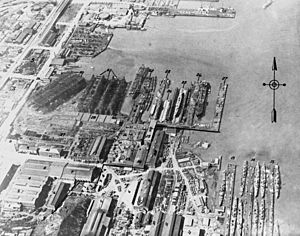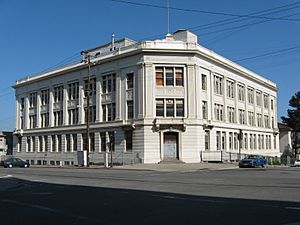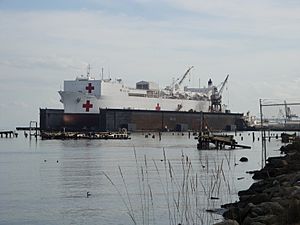Pier 70, San Francisco facts for kids
Pier 70 is a very old and important pier in San Francisco, California. It's located in the Potrero Point neighborhood. For many years, it was home to big shipbuilding companies like the Union Iron Works and later Bethlehem Shipbuilding. During the two World Wars, Pier 70 was one of the largest industrial areas in San Francisco. Today, it's known as the best-preserved industrial site from the 1800s west of the Mississippi River.
Contents
How Big is Pier 70?
The entire area of Pier 70 is about 65 acres (0.26 km2) in size. That's a lot of space!
A Look Back at Pier 70's History
The land around Pier 70 has been used for building ships ever since the California Gold Rush. This was a time when many people came to California looking for gold. Since 1883, when the Union Iron Works moved in, many different industrial companies have used Pier 70. These include the Pacific Rolling Mills, Risdon Iron & Locomotive, Kneass Boat Works, and BAE Systems.
In 1905, Bethlehem Steel bought the Union Iron Works. After that, Pier 70 also held Bethlehem Shipbuilding Corporation's main offices in a building called Building 101. Bethlehem Steel later sold its properties in the area to the Port of San Francisco in 1980.
In the 1990s, a large floating dry dock, which used to be the USS Steadfast (AFDM-14), was bought by BAE Systems. It is still used at the pier today.
Pier 70's Early Days and Growth
Pier 70 is on the eastern side of San Francisco's waterfront. It has been a key part of the city's industrial story since the mid-1800s. It first grew during the Gold Rush to help San Francisco's growing population and economy. Back then, Pier 70 was a busy center for building ships. The Union Iron Works started here in 1884 and became a major employer in the area.
Pier 70 During the World Wars
Pier 70 became even more important during the World Wars, especially World War II. During this time, Bethlehem Steel Corporation took over the pier. This made Pier 70 one of the biggest shipyards on the West Coast. It helped the country's navy by building many ships, including the famous Liberty ships. These ships were very important for the Allied forces during the war.
After the Wars: Changes at Pier 70
After World War II, shipbuilding at Pier 70 slowed down. This was part of a bigger change in industries everywhere. By the 1970s, the area started to look neglected as heavy industrial work decreased. However, people began to realize how important Pier 70's history was. They started working together to save and improve the site. This included the Port of San Francisco and private companies.
Pier 70 Today and Its Future
As of August 2025, Puglia Engineering, Inc. runs the ship repair facility at Pier 70. They bought it from BAE Systems Ship Repair in January 2017. Puglia Engineering also operates two other ship repair places in Washington State. The two dry docks at Pier 70 used to be run by BAE Systems San Francisco Ship Repair and employed about 200 people.
Many of the pier's old buildings have been empty since shipbuilding declined. But some historic buildings are still used. For example, one building is now home to artist studios.
In 2015, the Port of San Francisco began planning to redevelop Pier 70. They wanted to create a mix of commercial and residential spaces. This plan included about a thousand new homes and two million square feet of office space. Plans from 2013 also included a "Crane Cove Park." This park would show off the historic cranes in the northern part of the pier.
A big project to fix up eight historic buildings at the pier started in 2015. This $120 million effort was completed in 2017.
Some of the buildings are now used as a large event space, managed by Pier 70 Partners.
New Plans for the Pier 70 Area
The Dogpatch Neighborhood
Pier 70 is located on the eastern side of San Francisco, right in the middle of the Dogpatch neighborhood.
What's Happening Now
Pier 70 is currently undergoing a major transformation. The Port of San Francisco and Brookfield Properties are working together to turn the site into a mixed-use area. This new district will have local shops, restaurants, art studios, and workshops. It will also include homes and office spaces. The design focuses on streets that are easy for people to walk on and public outdoor areas.
The redevelopment plan for Pier 70 also includes new public parks, walkways along the water, and other fun outdoor spaces.
The plan includes:
- Homes and Businesses: New homes, business spaces, and office buildings are being built. They are designed to fit in with the area's industrial past.
- Saving History: Several historic buildings are being restored and given new uses. These include the Union Iron Works Machine Shop and the Bethlehem Steel Office Building.
- Public Spaces: New parks and open areas are being created. Access to the waterfront is also being improved for recreation and to make the area more beautiful.
- Being Green: The project uses environmentally friendly building methods. It also includes renewable energy and smart water systems to help the environment.
What's Next for Pier 70
The future vision for Pier 70 includes creating cultural and art spaces. It also aims to boost the economy by creating jobs and attracting businesses. The project continues to involve the community to make sure it meets local needs and interests.
Historic Buildings at Pier 70
Potrero Point is special enough to be listed on the National Register of Historic Places. This is because it played a role in three wars: the Spanish–American War, World War I, and World War II. It also has many buildings from the 1800s that are still standing. Some of these buildings are important enough to be landmarks on their own. These include the 1917 Frederick Meyer Renaissance Revival Bethlehem office building, the 1912 Power House#1 designed by Charles P. Weeks, the 1896 Union Iron Works office designed by Percy & Hamilton, and the huge 1885 Machine shops.




